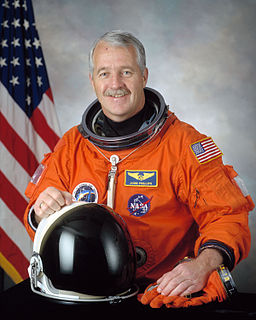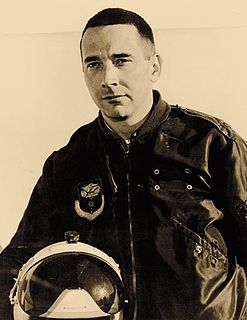
An aileron is a hinged flight control surface usually forming part of the trailing edge of each wing of a fixed-wing aircraft. Ailerons are used in pairs to control the aircraft in roll, which normally results in a change in flight path due to the tilting of the lift vector. Movement around this axis is called 'rolling' or 'banking'.

Henri Marie Coandă was a Romanian inventor, aerodynamics pioneer, and builder of an experimental aircraft, the Coandă-1910 described by Coandă in the mid-1950s as the world's first jet, a controversial claim disputed by some and supported by others. He invented a great number of devices, designed a "flying saucer" and discovered the Coandă effect of fluid dynamics.

The North American X-15 is a hypersonic rocket-powered aircraft. It was operated by the United States Air Force and the National Aeronautics and Space Administration as part of the X-plane series of experimental aircraft. The X-15 set speed and altitude records in the 1960s, reaching the edge of outer space and returning with valuable data used in aircraft and spacecraft design. The X-15's highest speed, 4,520 miles per hour, was achieved on 3 October 1967, when William J. Knight flew at Mach 6.7 at an altitude of 102,100 feet (31,120 m), or 19.34 miles. This set the official world record for the highest speed ever recorded by a crewed, powered aircraft, which remains unbroken.
Robert W. Bussard was an American physicist who worked primarily in nuclear fusion energy research. He was the recipient of the Schreiber-Spence Achievement Award for STAIF-2004. He was also a fellow of the International Academy of Astronautics and held a Ph.D. from Princeton University.

John Lynch Phillips is a NASA astronaut. Phillips is also a Naval Aviator and retired captain, United States Navy Reserve. Phillips has received numerous awards and special honors. He is a National Merit Scholar, graduated 2nd in his class of 906 people at the U.S. Naval Academy in 1972. Phillips has also been awarded the NASA Space Flight Medal, NASA Distinguished Service Medal, the Gagarin Medal and several others. Phillips has logged over 4,400 flight hours and 250 aircraft carrier landings, flying the A-7 Corsair II carrier-based light attack aircraft while on active duty in the Regular Navy and subsequently during his time as a Navy Reservist from 1982 to 2002. At the time of his retirement, Phillips had retained the rank of captain.
Thomas Baker Slick Jr. was a San Antonio, Texas-based inventor, businessman, adventurer, and heir to an oil business. Slick's father, Thomas Baker Slick Sr., a.k.a. "The King of the Wildcatters", had made a fortune during the Oklahoma oil boom of the 1910s. He was notable for discovering Oklahoma's then-largest oil field, the Cushing Oil Field.

AeroVironment, Inc. is an American defense contractor headquartered in Arlington, Virginia, that is primarily involved in unmanned aerial vehicles (UAVs). Paul B. MacCready Jr., a designer of human-powered aircraft, founded the company in 1971. The company is probably most well known for developing a series of lightweight human-powered and then solar-powered vehicles. AeroVironment is the Pentagon's top supplier of small drones — including the Raven, Wasp and Puma models.

A gyrodyne is a type of VTOL aircraft with a helicopter rotor-like system that is driven by its engine for takeoff and landing only, and includes one or more conventional propeller or jet engines to provide forward thrust during cruising flight. During forward flight the rotor is unpowered and free-spinning, like an autogyro, and lift is provided by a combination of the rotor and conventional wings. The gyrodyne is one of a number of similar concepts which attempt to combine helicopter-like low-speed performance with conventional fixed-wing high-speeds, including tiltrotors and tiltwings.

The Kashmir Princess, or Air India Flight 300, was a chartered Lockheed L-749A Constellation flight owned by Air India. On 11 April 1955, it was damaged in midair by a bomb explosion and crashed into the South China Sea while en route from Bombay, India, and Hong Kong to Jakarta, Indonesia. Sixteen of those on board were killed, while three survived. The explosion was an assassination attempt targeting Chinese Premier Zhou Enlai, who missed the flight due to a medical emergency and was not on board. The Chinese government concluded that the Kuomintang (KMT) were responsible for the bombing.
Dr. Lawrence Jerome Fogel was a pioneer in evolutionary computation and human factors analysis. He is known as the inventor of active noise cancellation and the father of evolutionary programming. His scientific career spanned nearly six decades and included electrical engineering, aerospace engineering, communication theory, human factors research, information processing, cybernetics, biotechnology, artificial intelligence, and computer science.
Leonard Michael Greene was an American inventor and aerodynamics engineer who held more than 200 patents, many of which are aviation-related. He is most well known for his contributions to aviation technology, including his invention, the Aircraft Stall Warning device, which warns pilots when a deadly aerodynamic stall is imminent. To build the device, Greene established the Safe Flight Instrument Corporation in 1946.

The Wright Brothers Medal was conceived of in 1924 by the Dayton Section of the Society of Automotive Engineers, and the SAE established it in 1927 to recognize individuals who have made notable contributions in the engineering, design, development, or operation of air and space vehicles. The award is based on contributed research papers.

The Gyrodyne RON Rotorcycle was a tiny, single-seat helicopter designed under contract for the United States Navy. in the mid-1950s. It later was redesigned for a U.S. Marine Corps requirement for a small personal helicopter that would fulfill a number of roles, including observation, liaison, small unit tactical maneuvers, and which could be dropped to downed airmen behind enemy lines to facilitate their escape.

The Wright brothers patent war centers on the patent they received for their method of an airplane's flight control. The Wright brothers were two Americans who are widely credited with inventing and building the world's first flyable airplane and making the first controlled, powered and sustained heavier-than-air human flight on December 17, 1903.

Walter J. Boyne was a United States Air Force officer, Command Pilot, combat veteran, aviation historian, and author of more than 50 books and over 1,000 magazine articles. He was a director of the National Air and Space Museum of the Smithsonian Institution and a Chairman of the National Aeronautic Association.
Solar Turbines Incorporated, a wholly owned subsidiary of Caterpillar Inc., designs and manufactures industrial gas turbines for onshore and offshore electrical power generation, for marine propulsion and for producing, processing and transporting natural gas and oil.

The HZ-1 Aerocycle, also known as the YHO-2 and by the manufacturer's designation DH-5 Aerocycle, was an American one-man "personal helicopter" developed by de Lackner Helicopters in the mid-1950s. Intended to be operated by inexperienced pilots with a minimum of 20 minutes of instruction, the HZ-1 was expected to become a standard reconnaissance machine with the United States Army. Although early testing showed that the craft had promise for providing mobility on the atomic battlefield, more extensive evaluation proved that the aircraft was in fact too difficult to control for operation by untrained infantrymen, and after a pair of crashes the project was abandoned. A single model of the craft was put on display.

Lieutenant-Colonel Sir Francis Kennedy McClean, was a British civil engineer and pioneer aviator.
A cruciform wing is a set of four individual wings arranged in the shape of a cross. The cross may take either of two forms; the wings may be equally spaced around the cross-section of the fuselage, lying in two planes at right angles, as on a typical missile, or they may lie together in a single horizontal plane about a vertical axis, as in the cruciform rotor wing or X-wing.
Wendell F. Moore was an American aeronautical engineer, known as a jet pack inventor.













